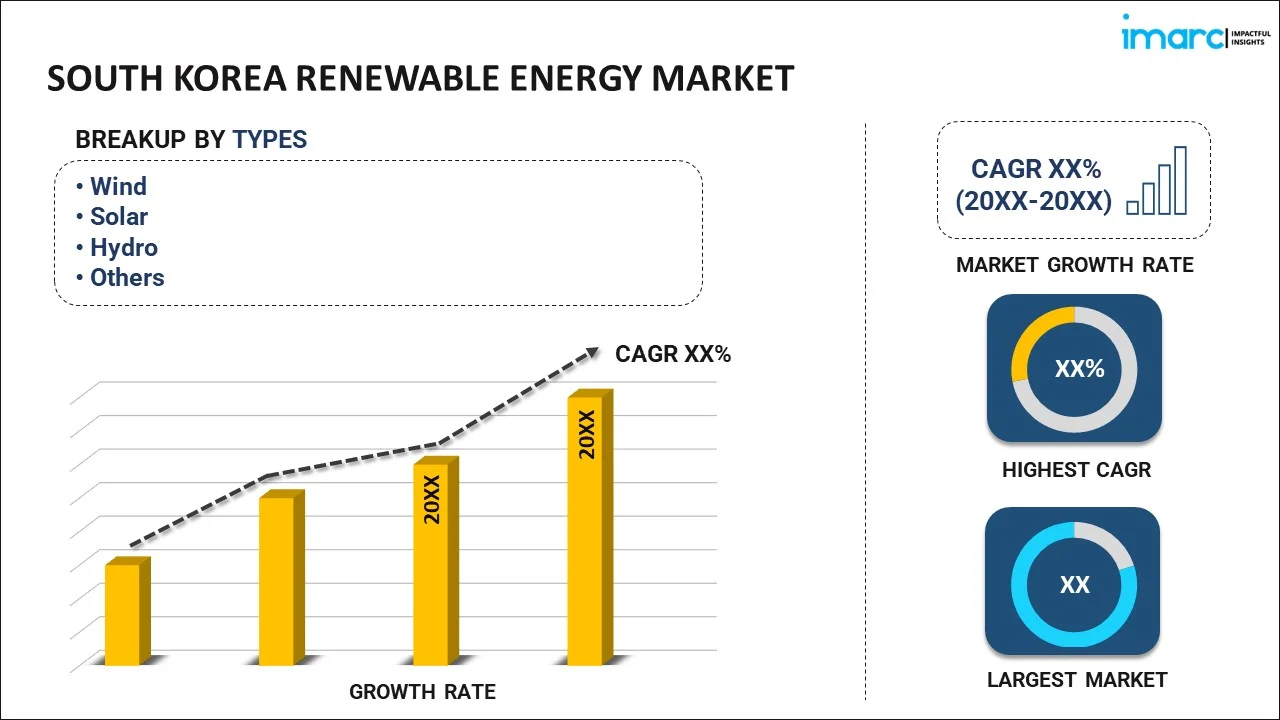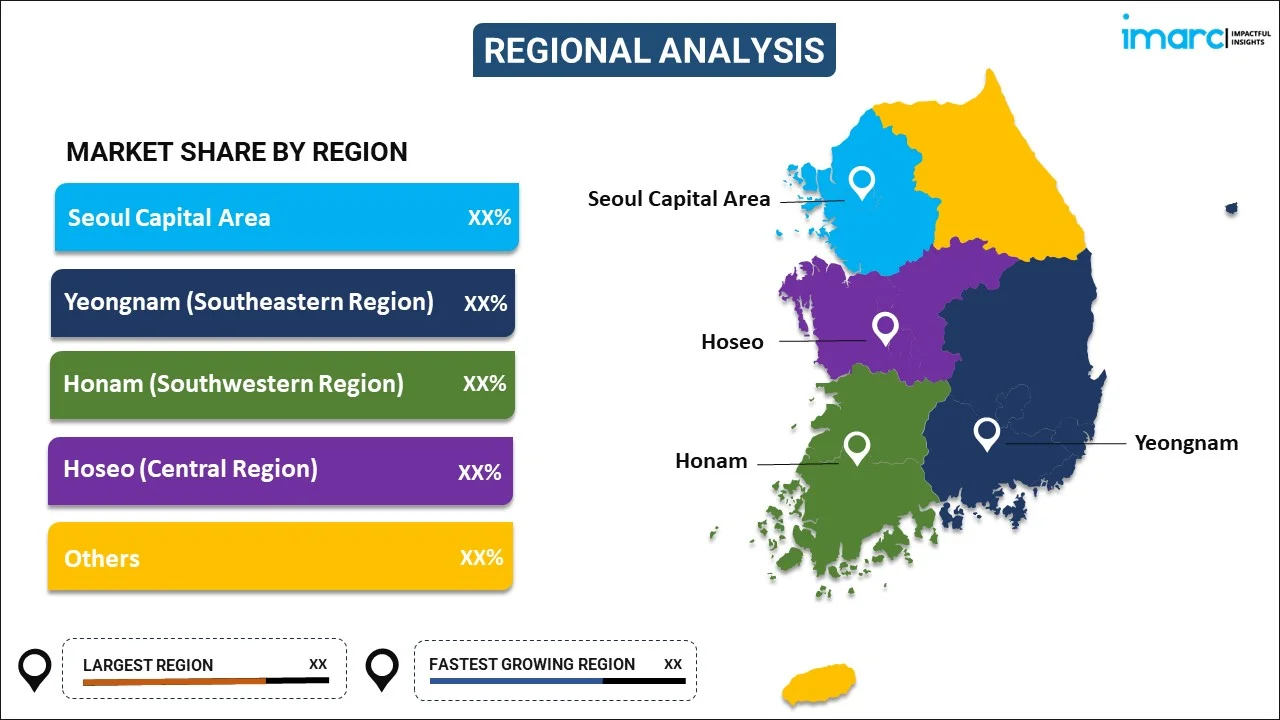
South Korea Renewable Energy Market Report by Type (Wind, Solar, Hydro, and Others), End User (Industrial, Residential, Commercial), and Region 2025-2033
South Korea Renewable Energy Market:
South Korea renewable energy market size reached 55.6 TWh in 2024. Looking forward, IMARC Group expects the market to reach 124.7 TWh by 2033, exhibiting a growth rate (CAGR) of 8.6% during 2025-2033. The implementation of favorable governmental policies like the Renewable Portfolio Standard, continuous technological advancements in clean energy, and heightened demand for sustainable energy solutions across the country represent some of the key factors driving the market.
|
Report Attribute
|
Key Statistics
|
|---|---|
|
Base Year
|
2024
|
|
Forecast Years
|
2025-2033
|
|
Historical Years
|
2019-2024
|
|
Market Size in 2024
|
55.6 TWh |
|
Market Forecast in 2033
|
124.7 TWh |
| Market Growth Rate 2025-2033 | 8.6% |
South Korea Renewable Energy Market Analysis:
- Major Market Drivers: A combination of governmental policies, technological advancements, and societal demand for sustainable energy solutions is driving the market's growth. Additionally, the government of South Korea is offering financial incentives, such as tax benefits and subsidies, to encourage both businesses and consumers to adopt renewable energy solutions, further propelling the South Korea renewable energy market demand.
- Key Market Trends: The rising investments in research and development (R&D) to make renewable energy sources, like solar, wind, and hydroelectric power, more efficient and cost-effective are driving the South Korea renewable energy market growth. Besides this, the heightened public awareness and the societal push for sustainability are other major growth-inducing factors.
- Competitive Landscape: The South Korea renewable energy market analysis report has also provided a comprehensive analysis of the competitive landscape in the market. Also, detailed profiles of all major companies have been provided.
- Geographical Trends: The Seoul Capital Area, including Seoul, Incheon, and Gyeonggi Province, has a significant demand for renewable energy driven by its large population, high energy consumption, and ambitious environmental policies. Moreover, Yeongnam, which includes areas like Busan, Ulsan, and Gyeongsangbuk-do, is more industrialized and has a significant energy consumption profile. There's growing interest in renewable energy, especially in wind and solar power.
- Challenges and Opportunities: The high initial cost of renewable energy projects and the rising dependency on fossil fuels are hampering the market's growth. However, South Korea's government has set ambitious targets for reducing greenhouse gas emissions and increasing the share of renewable energy. This support can drive growth in the sector through subsidies, incentives, and regulatory frameworks.
South Korea Renewable Energy Market Trends:
Growing Urbanization
The growing urbanization is a significant driver of the renewable energy market in South Korea. For instance, according to Statista, in 2022, around 47.3 million people lived in metropolitan areas in South Korea. Around 91.9% of South Korean inhabitants resided in cities that year. Urban areas typically experience higher energy consumption due to the concentration of residential, commercial, and industrial activities. This increased demand creates a strong incentive to diversify energy sources and integrate more renewable energy solutions to meet the needs of urban populations. These factors are further positively influencing the South Korea renewable energy market forecast.
Rising Financial Incentives
South Korea offers various financial incentives, such as subsidies, tax breaks, and feed-in tariffs (FiTs) or power purchase agreements (PPAs), to encourage the development and deployment of renewable energy projects. For instance, in April 2023, South Korea's Ministry of Trade, Industry, and Energy (MOTIE) allocated KRW 244.7 billion (US$185.5 million) for its rebate program for rooftop PV systems and other small renewable energy systems. These incentives help reduce the financial risk for developers and investors. These factors are further contributing to the South Korea renewable energy market share.
Government Policies and Targets
The South Korean government has set ambitious renewable energy targets as part of its Green New Deal and 2050 carbon neutrality goals. The country aims to reduce its reliance on fossil fuels and increase the share of renewables in its energy mix. For instance, in July 2020, South Korea announced its Green New Deal (GND), which includes a promise to generate 20% of the country's power from renewable sources by 2030. It also planned to invest 9.2 trillion won (USD 6.8 billion) in wind, solar, and hydrogen by 2025, as well as build 12 gigawatts of offshore wind power by 2030. These factors are augmenting the South Korea renewable energy market demand.
South Korea Renewable Energy Market Segmentation:
IMARC Group provides an analysis of the key trends in each segment of the market, along with forecasts at the country and regional levels for 2025-2033. Our report has categorized the market based on type and end user.
Breakup by Type:

- Wind
- Solar
- Hydro
- Others
The report has provided a detailed breakup and analysis of the market based on the type. This includes wind, solar, hydro, and others.
According to the South Korea renewable energy market outlook report, solar energy has seen substantial growth in South Korea, driven by declining costs of photovoltaic (PV) technology and supportive government policies. The country has been focusing on expanding its solar capacity through large-scale solar farms, rooftop installations, and floating solar projects. Moreover, onshore wind power has been growing steadily, with several large wind farms being developed across the country. South Korea has significant wind energy potential, particularly in coastal and rural areas. Besides this, South Korea has a well-established hydroelectric power infrastructure, with several large dams and hydroelectric plants already in operation.
Breakup by End User:
- Industrial
- Residential
- Commercial
A detailed breakup and analysis of the market based on the end user have also been provided in the report. This includes industrial, residential, and commercial.
According to the South Korea renewable energy market outlook, the industrial sector is a major consumer of energy in South Korea, with significant demand for electricity and heat. Industries are increasingly looking for renewable energy to manage energy costs and meet sustainability goals. Moreover, the industrial sector is a major consumer of energy in South Korea, with significant demand for electricity and heat. Industries are increasingly looking to renewable energy to manage energy costs and meet sustainability goals. Besides this, commercial buildings, including office spaces, shopping centers, and warehouses, are increasingly installing solar panels. The installation of solar PV systems on rooftops and in parking lots is becoming more common, further driving the market's growth.
Breakup by Region:

- Seoul Capital Area
- Yeongnam (Southeastern Region)
- Honam (Southwestern Region)
- Hoseo (Central Region)
- Others
The report has also provided a comprehensive analysis of all the major regional markets, which include Seoul Capital Area, Yeongnam (Southeastern Region), Honam (Southwestern Region), Hoseo (Central Region), and others.
According to the South Korea renewable energy market statistics, the Seoul Metropolitan Government has been proactive in promoting renewable energy through policies, such as mandatory solar installations on new buildings, energy efficiency programs, and green building certifications. Moreover, Yeongnam, which includes cities such as Busan, Ulsan, and Daegu, is a major industrial and manufacturing hub. The region has a high demand for energy driven by its industrial base. Besides this, Honam, including cities like Gwangju and Jeonju, has a mix of agricultural and residential areas. While energy demand is lower compared to the capital region, there is growing interest in renewable energy.
Competitive Landscape:
The South Korea renewable energy market research report has also provided a comprehensive analysis of the competitive landscape in the market. Competitive analysis such as market structure, key player positioning, top winning strategies, competitive dashboard, and company evaluation quadrant has been covered in the report. Also, detailed profiles of all major companies have been provided.
South Korea Renewable Energy Market News:
- August 2024: South Korea’s Vice Minister of Trade, Industry, and Energy launched the Offshore Wind Power Competitive Bidding Roadmap during a conference with industry leaders at the Korea Chamber of Commerce and Industry (KCCI) in Seoul.
- July 2024: Peak Energy signed an agreement with Shinsung E&G and YSP to establish a 50 MW solar portfolio in South Korea.
- June 2024: The South Korean government announced the auction for clean-hydrogen-fired power generation, for up to 6,500GWh per year — roughly equivalent to a 100MW baseload power plant working at full capacity all year — over a 15-year period beginning in 2028.
South Korea Renewable Energy Market Report Scope:
| Report Features | Details |
|---|---|
| Base Year of the Analysis | 2024 |
| Historical Period | 2019-2024 |
| Forecast Period | 2025-2033 |
| Units | TWh |
| Scope of the Report | Exploration of Historical Trends and Market Outlook, Industry Catalysts and Challenges, Segment-Wise Historical and Predictive Market Assessment:
|
| Types Covered | Wind, Solar, Hydro, Others |
| End Users Covered | Industrial, Residential, Commercial |
| Regions Covered | Seoul Capital Area, Yeongnam (Southeastern Region), Honam (Southwestern Region), Hoseo (Central Region), Others |
| Customization Scope | 10% Free Customization |
| Post-Sale Analyst Support | 10-12 Weeks |
| Delivery Format | PDF and Excel through Email (We can also provide the editable version of the report in PPT/Word format on special request) |
Key Questions Answered in This Report:
- How has the South Korea renewable energy market performed so far and how will it perform in the coming years?
- What has been the impact of COVID-19 on the South Korea renewable energy market?
- What is the breakup of the South Korea renewable energy market on the basis of type?
- What is the breakup of the South Korea renewable energy market on the basis of end user?
- What are the various stages in the value chain of the South Korea renewable energy market?
- What are the key driving factors and challenges in the South Korea renewable energy?
- What is the structure of the South Korea renewable energy market and who are the key players?
- What is the degree of competition in the South Korea renewable energy market?
Key Benefits for Stakeholders:
- IMARC’s industry report offers a comprehensive quantitative analysis of various market segments, historical and current market trends, market forecasts, and dynamics of the South Korea renewable energy market from 2019-2033.
- The research report provides the latest information on the market drivers, challenges, and opportunities in the South Korea renewable energy market.
- The study maps the leading, as well as the fastest-growing, regional markets. It further enables stakeholders to identify the key country-level markets within each region.
- Porter's five forces analysis assists stakeholders in assessing the impact of new entrants, competitive rivalry, supplier power, buyer power, and the threat of substitution. It helps stakeholders to analyze the level of competition within the South Korea renewable energy industry and its attractiveness.
- The competitive landscape allows stakeholders to understand their competitive environment and provides insight into the current positions of key players in the market.
Need more help?
- Speak to our experienced analysts for insights on the current market scenarios.
- Include additional segments and countries to customize the report as per your requirement.
- Gain an unparalleled competitive advantage in your domain by understanding how to utilize the report and positively impacting your operations and revenue.
- For further assistance, please connect with our analysts.
 Inquire Before Buying
Inquire Before Buying
 Speak to an Analyst
Speak to an Analyst
 Request Brochure
Request Brochure
 Request Customization
Request Customization




.webp)




.webp)












